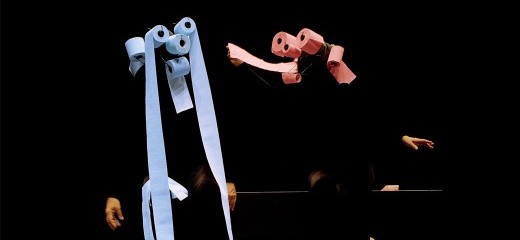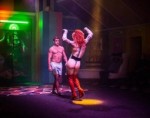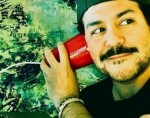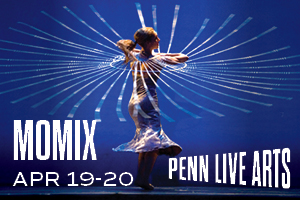
Photo: Pia Zanetti
Universal Gestures
by Whitney Weinstein
What an entrance! Two comically overgrown hands slowly emerged from backstage, attempting to draw back the curtain. Their magnified gestures—a point, a wave, a hug between hands—had the audience laughing immediately. Next thing I realized, an audience member had disappeared into the clutch of one of the huge, grayish hands. In my mind,
Giant Hands was a game: how many different ways can a hand move?
MUMMENSCHANZ, established in Paris in 1972 by Bernie Schürch, Andres Bossard, and Floriana Frassetto, evolved from experimental explorations, combining its founders' various trainings. The company members perform as barefoot pantomimes, storytellers, modern dancers and puppeteers. Following the company’s run on Broadway, the ensemble incorporated the use of masks, and began touring worldwide. With its playful use of props and exaggerated movement along with minimal sets and sound, the group’s nonverbal expression speaks across populations and decades to convey timeless messages.
The scenes in MUMMENSCHANZ’s performance were vignettes, most lasting under five minutes. In Slinky Man, a tube with open ends, similar to a construction pipe, shuffled onto the stage, upright, balancing a large, red ball on its higher opening. Each end had an intriguing, subtle suctioning tension. The first task: bounce the ball and re-establish balance, almost like a stringless game of paddleball. Next task: mount a platform. From there, the Slinky Man grew curious about connecting its two open ends, eventually sealing itself into a circle.
Other vignettes had a clear plot. In Clay Masks, two individuals transformed the clay of their malleable masks, distorting proportions through elongation and squishing, twisting and flattening, imitating animals like elephants and monkeys or characters with long noses and pointy chins. Eventually, they lost their own individual expressions trying to metamorphose into the appearance of the other. The scene ended in their uniting, maybe even becoming the other, as they grew blinded, literally, by the clay in their eyes. Their faces smacked and stuck together.
Another vignette introduced a character with a blank, black box as a head that ventured into the audience with masking tape, silently requesting unsuspecting viewers to decorate its face. The figure blindly accepted the participant’s created expression, implying the character’s vulnerability to the actions of others.
I associated movement qualities and animated plot lines with certain life experiences. After multiple failed attempts with Slinky Man trying to climb the riser, he hit the floor with a thump of frustration. MUMMENSCHANZ uses human actions to bring muted expression to nonhuman forms, helping to generalize anecdotes into universal tales. The relatable stories unite diverse viewers from around the globe, inviting people to find humor, lightheartedness and significance in the human experience. The audience cheered and booed, whimpered and giggled. They applauded when Slinky Man finally stood on top of the platform, victorious! When a character failed, showing disappointment in a downward gaze, the audience sighed.
In one extremely brief moment, grotesque masks were transformed into cubism-inspired fragments and facial features were scrambled and rearranged. An image of lips was slid to the forehead and an eye moved to the side. Expressions were constantly shifting, urging viewers to frequently consider new perspectives. In every scene, MUMMENSCHANZ’s efforts of nonverbal communications are particularly accessible and complex. Still toasting their 40th anniversary, the four-person cast of this show will continue across the States before completing this celebratory tour towards the end of 2015.
MUMMENSCHANZ, Annenberg Center for the Performing Arts, December 11-14.
By Whitney Weinstein
December 23, 2014







.png)


